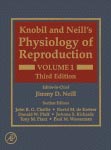Chapter 22 - The Epididymis
B Robaire, BT Hinton, MC Orgebin-Crist
Plates (1st Edition)
Fig. 76
Number of condensed sperm heads in the rat testis (striped), caput ( ), and cauda (dots) epididymidis as a function of age
Figs. 77-78
Cross-section through the cytoplasmic droplet (CD) of a sperm located in the lumen of the caput epididymidis
The cytoplasmic droplet (CD) of a sperm located in the lumen of the corpus epididymidis. In this case the droplet appears to be in the process of being shed from the flagellum (F)
Fig. 79
Lumen (Lu) of the cauda epididymidis
Fig. 80
A spermatozoon (S) present in the lumen (Lu) of the cauda epididymidis
Fig. 81
A residual body (RB) located in the lumen (Lu) of the corpus epididymidis, identified by the presence of many mitochondria (m), large vacuoles (V ), and clusters of ribosomes (arrowhead)
Fig. 82
Schematic representation showing the position of the cytoplasmic droplet of spermatozoa in the testis and various segments of the epididymis and its ultimate fate
Fig. 83
Transit time in days for spermatozoa to traverse the caput (shaded), corpus (clear) and cauda (striped) epididymidis
Fig. 84
Approximate site within the epididymis where spermatozoa acquire their fertilizing ability
Fig. 85
Effect of increasing doses of testosterone (●), dihydrotestosterone (X), 5α-androstan-3α, 17β-diol (Δ), and 5α-androstan-3β, 17β-diol (o), injected daily, on the maintenance of the fertilizing ability of spermatozoa in the ligated hamster cauda epididymidis 1 week after castration
Fig. 86
Subcellular localization of 5α-reductase activity during development in the caput-corpus and cauda epididymidis
Fig. 87
Effects of various lipids (A) and phosphatidylcholines with defined acyl structure (B) on the specific activity of rat epididymal 5α-reductase
Fig. 88
Grain number over principal cell nuclei of mouse epididymis after injection of tritiated dihydrotestosterone (DHT) or tritiated estradiol (E2)
Fig. 89
Fertilizing ability of spermatozoa from the distal cauda epididymidis of the rabbit as a function of time after either castration or hypophysectomy (HYPOX)
Fig. 90
Formation of 5α-reduced metabolites of testosterone by isolated rat caput epididymal principal cells incubated for 15 hr in serum-free medium at various temperatures ranging from 25 to 40ºC















